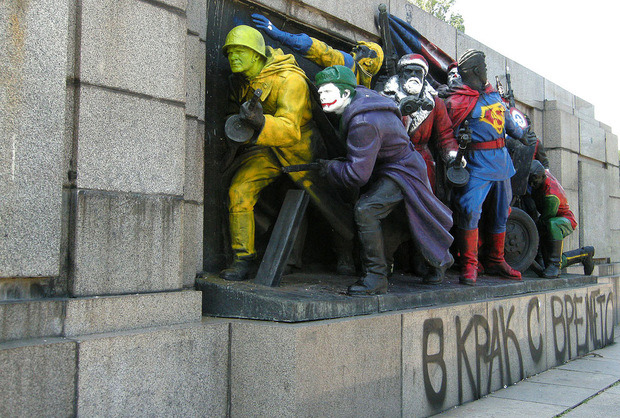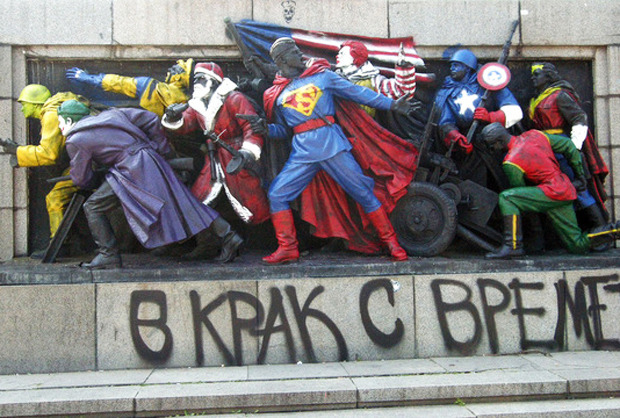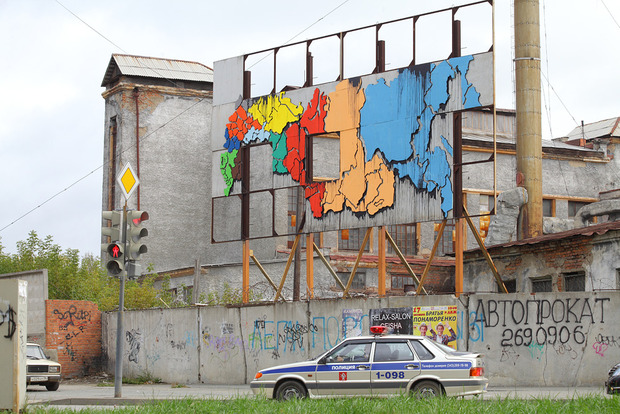Today contemporary art, exhibited in museums, has become a tool of the system, a dialogue with the dominant trends of the artist and ideas, and in this sense is no longer a progressive and avant-garde. Street art, involving a radical refusal to participate in the mainstream, it has become an alternative to off-system, and the political street art - a tool by which an individual can ask a progressive society topical and often sensitive issue, essential to encourage discussion.
Political street art flourishes in places of historical tragedies or ethnic conflicts, social or economic tensions. Street artists sharply and quickly respond to any problems in society. Young creative people are willing to speak out loudly and publicly and to the widest possible audience. Of course, the most effective to do it on the wall, preferably in a public place. Such a statement - text or visual - is preserved at least until the next repair and becomes part of the urban space, calls for dialogue, forming an opinion, agitating. Street art asks questions and highlights problems indicates the eternal values, which are often overlooked, solving immediate problems.
In Sofia in June 2011 street artists painted the figures of Soviet soldiers on the monument in honor of Bulgaria's liberation from German occupation during World War II. For a few days they turned into Superman, McDuck, Santa Claus and other comic book characters. Signature: "In step with the times." This event caused a major debate on the development of modern Bulgaria, rethinking its socialist past.
Beirut - a city torn apart by contradictions, a former French colony, "Switzerland Middle East" - has suffered in recent years, several wars, torn by internal contradictions and interfaith ongoing conflict with neighboring Israel. According to travelers, the city densely covered with small, but powerful stereotyped images.
The economic crisis that hit Greece in recent years, could not find a response from the street artists. The turning point was the murder of a policeman fifteen teenagers on one of the social protest demonstrations in 2008. In the streets are many signs and stencils, but pay special attention to the work itself «Bleeps», dedicated to the Greek foreign debt and weak government, "sell" the country of international funds.
Political street art situational, often made in very poor artistic technique, in most cases, anonymous. But it is still a form of ultra-modern urban art, which uses a very powerful impact on the viewer. "Reading the City" is also the process of creating the city. Thus, the street-art involves citizens in the process of production of urban space, transforming passive observers collaborators. But only when it is in its urban context. As soon as his attempt to "tame" - to publish or display album art in a museum, he loses his powers.
When the walls of Cairo appeared rebellious stencils and simple drawings - they inspired the crowd awakened revolutionary consciousness and lead to change. When these same images were published huge glossy album - the energy was gone, a book may be of interest only to historians and critics, but surely impress mere spectators. By drawing on the walls, artists expressed alarm zeitgeist, not trying to convert it into the software and specific policy statement, clearly defining the goals and objectives of collective resistance.
A similar process is going on in Russia. Graffiti appear avalanche every time there is a reason for this. The city responded to the elections and the case Pussy Riot. Manifestation of political street art can be considered and many funny and creative slogans at rallies recently. It is surprising that the activists did not occur to perpetuate them on the streets of Moscow.
But street art has responded to more global issues, catching the fragile environment of recent times. Stability, responsibility, the position of women in society - all became subjects of works of street art, not only in the capital but also in other major Russian cities.
Where street art has appeared long ago - in the U.S. or the UK, for example, authorities are trying to tame it. Recently in Bristol, one of the recognized centers of street art, the home of the famous Banksy, the authorities issued a municipal law for the protection of works of street art. This seems to be a positive decision kills the very essence of rebellious movements, giving the government the ability to decide what is valuable and needs protection, but that does not quite live up to their own invented criteria.
Berlin city government has regretted the decision to destroy the works of the political street art, which once adorned the famous Berlin Wall. Twenty years after the fall of the wall was rebuilt piece nine hundred meters long, which meticulously struck up street art, including the famous kiss between Brezhnev and Honecker.
In 2007, the London-based collective of "Santa's Ghetto" mobilized several stars of the world of street art - Banksy, BLU, Ron English, Swoon - to paint the vast expanses of concrete separation barrier between Israel and the Palestinian Authority in the town of Bethlehem. It is noteworthy that the Palestinians themselves, by no means foreign to Street-art in their own cities, did not participate in the project, citing the refusal by this barrier, a symbol of oppression and apartheid, should be gray and ugly as the occupation itself.
The new reality is created at night, in the dark, arms by an unknown artist without a face and a name. Street art - one of the few ways to express themselves, independent of financial investments, curators and system institutions. Therefore, it so hard to fight and it is so exciting to find examples in their backyard: you feel that you live in interesting times.
Political street art flourishes in places of historical tragedies or ethnic conflicts, social or economic tensions. Street artists sharply and quickly respond to any problems in society. Young creative people are willing to speak out loudly and publicly and to the widest possible audience. Of course, the most effective to do it on the wall, preferably in a public place. Such a statement - text or visual - is preserved at least until the next repair and becomes part of the urban space, calls for dialogue, forming an opinion, agitating. Street art asks questions and highlights problems indicates the eternal values, which are often overlooked, solving immediate problems.
In Sofia in June 2011 street artists painted the figures of Soviet soldiers on the monument in honor of Bulgaria's liberation from German occupation during World War II. For a few days they turned into Superman, McDuck, Santa Claus and other comic book characters. Signature: "In step with the times." This event caused a major debate on the development of modern Bulgaria, rethinking its socialist past.
Beirut - a city torn apart by contradictions, a former French colony, "Switzerland Middle East" - has suffered in recent years, several wars, torn by internal contradictions and interfaith ongoing conflict with neighboring Israel. According to travelers, the city densely covered with small, but powerful stereotyped images.
The economic crisis that hit Greece in recent years, could not find a response from the street artists. The turning point was the murder of a policeman fifteen teenagers on one of the social protest demonstrations in 2008. In the streets are many signs and stencils, but pay special attention to the work itself «Bleeps», dedicated to the Greek foreign debt and weak government, "sell" the country of international funds.
Political street art situational, often made in very poor artistic technique, in most cases, anonymous. But it is still a form of ultra-modern urban art, which uses a very powerful impact on the viewer. "Reading the City" is also the process of creating the city. Thus, the street-art involves citizens in the process of production of urban space, transforming passive observers collaborators. But only when it is in its urban context. As soon as his attempt to "tame" - to publish or display album art in a museum, he loses his powers.
When the walls of Cairo appeared rebellious stencils and simple drawings - they inspired the crowd awakened revolutionary consciousness and lead to change. When these same images were published huge glossy album - the energy was gone, a book may be of interest only to historians and critics, but surely impress mere spectators. By drawing on the walls, artists expressed alarm zeitgeist, not trying to convert it into the software and specific policy statement, clearly defining the goals and objectives of collective resistance.
A similar process is going on in Russia. Graffiti appear avalanche every time there is a reason for this. The city responded to the elections and the case Pussy Riot. Manifestation of political street art can be considered and many funny and creative slogans at rallies recently. It is surprising that the activists did not occur to perpetuate them on the streets of Moscow.
But street art has responded to more global issues, catching the fragile environment of recent times. Stability, responsibility, the position of women in society - all became subjects of works of street art, not only in the capital but also in other major Russian cities.
Where street art has appeared long ago - in the U.S. or the UK, for example, authorities are trying to tame it. Recently in Bristol, one of the recognized centers of street art, the home of the famous Banksy, the authorities issued a municipal law for the protection of works of street art. This seems to be a positive decision kills the very essence of rebellious movements, giving the government the ability to decide what is valuable and needs protection, but that does not quite live up to their own invented criteria.
Berlin city government has regretted the decision to destroy the works of the political street art, which once adorned the famous Berlin Wall. Twenty years after the fall of the wall was rebuilt piece nine hundred meters long, which meticulously struck up street art, including the famous kiss between Brezhnev and Honecker.
In 2007, the London-based collective of "Santa's Ghetto" mobilized several stars of the world of street art - Banksy, BLU, Ron English, Swoon - to paint the vast expanses of concrete separation barrier between Israel and the Palestinian Authority in the town of Bethlehem. It is noteworthy that the Palestinians themselves, by no means foreign to Street-art in their own cities, did not participate in the project, citing the refusal by this barrier, a symbol of oppression and apartheid, should be gray and ugly as the occupation itself.
The new reality is created at night, in the dark, arms by an unknown artist without a face and a name. Street art - one of the few ways to express themselves, independent of financial investments, curators and system institutions. Therefore, it so hard to fight and it is so exciting to find examples in their backyard: you feel that you live in interesting times.






























